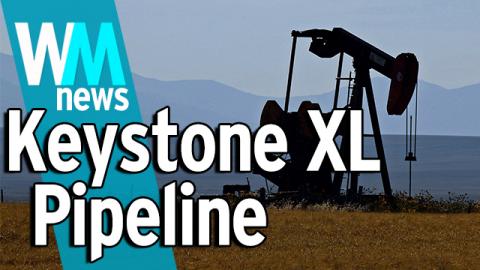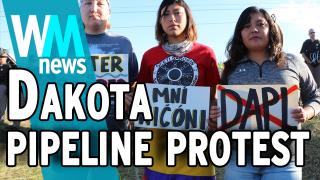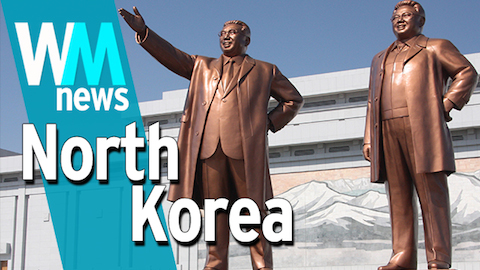10 Keystone Pipeline Facts - WMNews Ep. 18

Delays, political debate and a Presidential veto have helped make this a hot-button political issue. Welcome to WatchMojo News, the weekly series from http://www.WatchMojo.com that breaks down news stories that might be on your radar. In this instalment, we're counting down 10 crucial facts you should know about the Keystone Pipeline.
10 Keystone Pipeline Facts - WMNews Ep. 18
Dakota Pipeline Protest Crackdown! 5 Need to Know Facts!
Delays, political debate and a Presidential veto have helped make this a hot-button political issue. Welcome to WatchMojo News, the weekly series from http://www.WatchMojo.com that breaks down news stories that might be on your radar. In this instalment, we’re counting down 10 crucial facts you should know about the Keystone Pipeline.
#10: What Is the Keystone Pipeline? The Keystone XL Project
10 Reddit Facts - WMNews Ep. 37
The brainchild of the TransCanada Corporation, a Canadian energy company based in Alberta, Canada, the Keystone Pipeline is a pipeline that channels increased amounts of oil from Alberta’s oil sands to the United States – up to 830,000 barrels per day. In existence since 2005, the project was heavily criticized up North; however, in 2007 the Canadian government approved the pipeline’s construction on its home soil, followed by the U.S.-approved Phase I a year later. The first three phases of the project were completed and online by 2015, as the contentious fourth phase – referred to as Keystone XL – remained incomplete. Phase IV was essentially a quicker route to and from the same locations as the Phase I project with more direct access into states like Texas; however, because its proposed route passes over Nebraska’s Ogallala Aquifer – a vital source of water used for drinking, farming and more – this portion of the project has been even more highly debated than Phases I-III.
#9: How Is the Keystone Different from Other Pipelines? The Scale
Because of its sheer size and scope, and because it crosses the border between two countries, spanning several states and provinces with over 2,000 miles of pipeline, the Keystone pipeline brings with it unique political challenges. For example, the project required approval from the Canadian government, as well as the United States government in the form of an environmental impact assessment and a national interest assessment. After over two years of paperwork, TransCanada finally secured the permits required for the project. However, Phase IV remains in limbo as U.S. President Barack Obama makes his conclusive choice on whether or not to approve the pipeline.
#8: Why Is This Issue So Contentious? The Debate
10 USA Gun Rights Debate Facts - WMNews Ep. 33
As it stands, there are roughly 70 pipelines that cross the borders between the U.S. and Canada, with some transporting oil and others natural gas. But the Keystone XL project was brought to the attention of the public, as environmentalists, economists and politicians all weighed in. Environmentalists across the globe point say that it’s a huge drawback that some of the oil traveling through the pipeline comes from Alberta’s oil sands. To extract usable oil from this source is not only labor intensive, but also energy intensive – meaning that oil derived from oil sands produces significantly more greenhouse-gas emissions from start-to-finish than its more traditional counterparts. Economists say that, since the U.S. economy still depends on oil in a big way, this project would be a huge boon to the country. The debate among American politicians is split along party lines, with President Obama torn between his environmentally minded supporters and the 61% of Americans who approve of the pipeline. The Republican-controlled Congress hopes to force the President into okaying the project.
#7: Who Opposes the Keystone XL Pipeline? The Environmental Organizations
10 Volkswagen Scandal Facts WMNews Ep. 47
It’s mainly environmental groups and climate change experts who oppose the pipeline, as they viewed the original path of the XL pipeline as a disastrous move with potentially massive repercussions. Environmentalists worry about the pipeline not only because this would enable America to remain dependent on oil – which they say will soon lead to irreparable damage in terms of climate change – but also because using oil from the oil sands will inherently lead to an increase in greenhouse-gas emissions. What’s more, there are concerns about leaks along the pipeline, and those worries are not unfounded: Phase I had over a dozen accidents during its first year, and residents living near the proposed pipeline locations mentioning oil spills as a worst-case-scenario.
#6: Who Supports the Keystone XL Pipeline? The Energy Companies
10 SABMiller Takeover Facts - WMNews Ep. 50
Support for this pipeline has come from various factions, including the Canadian government, TransCanada, major labor unions, and large refineries that have already signed multi-year contracts for future oil refinery operations. Over half of the U.S. population has also expressed support for the project. The State Department has estimated that the pipeline would create 5,000-6,000 jobs in the U.S., while other sources put that number much lower. In addition, the current method of crude oil transportation between Canada and the United States is via rail, and recently there have been several serious accidents involving trains carrying oil, making the pipeline seem like a more favorable option. Proponents of the pipeline also mention the benefit of not depending on foreign oil from countries like Saudi Arabia or Nigeria. And finally, the ties this project would create between the U.S. and Canada are cited as invaluable.
#5: Why Is Approval of Keystone XL Taking So Long? The Red Tape
Phase IV of the project, the controversial Keystone XL phase, was delayed in order to give the government enough time to properly examine the project. This is despite of the State Department’s environmental impact report, which claimed that the XL pipeline would cause “no significant impact.” This report immediately drew criticism from environmentalist groups who believe it downplayed the effect of the pipeline. In addition, documents obtained under the Freedom of Information Act show that the TransCanada had previously worked with the contractor they recommended to help with the State Department’s study, seriously calling its legitimacy into question.
#4: How Will the Keystone Pipeline Affect the Environment? The Carbon Emissions
While the State Department concluded that the pipeline would have a minimal impact on the environment; however, they also said that development of Canada’s oil sands industry would lead to higher greenhouse-gas emissions. And, according to the non-profit environmental advocacy group the Natural Resources Defense Council, the amount of carbon added to our atmosphere as a result of Keystone XL over the next five decades would be more than the combined emissions of every car in the U.S. over the course of one year. In addition, the rules of supply and demand suggest that with more oil available, prices will drop, and therefore consumption will increase – thereby again increasing the carbon footprint of the pipeline.
#3: Does North America Need the Oil? The Overload
10 North Korea Facts - WMNews Ep. 5
North America has been experiencing an energy boom, with jobs being created and costs being lowered. This new infrastructure would keep that boom going, and would weaken North American dependence on foreign oil even further. However, as environmentalists are hoping to shift energy sources from oil to something more environmentally friendly, the need for oil in North America is relative.
#2: How Did the White House Vote? The Veto
10 Hillary Clinton White House Bid Facts - WMNews Ep. 23
After the Senate approved the construction of the Keystone XL pipeline at the end of January, President Obama vetoed the bill on February 24th, 2015. In explaining his decision, Obama explained that the bill was an attempt by the Republican-led Congress to make a decision that should be a task for the President. He also questioned whether such a pipeline was truly in the country’s best interest. A few weeks later, Republicans tried to overrule the presidential veto, but failed to reach the two-thirds majority in terms of votes that would have been necessary to do so.
#1: Who Has the Final Decision on the Keystone XL Pipeline? The Senate and the White House
Because they were unable to overrule the presidential veto, some Senate members hinted that the battle is not over, and that they might attach the pipeline to other legislation in the future that the President will not want to veto. In the meantime, Canada plans to increase its oil sands production regardless of the outcome of the Keystone Pipeline issue, and will thus search for viable alternatives, such as the construction of the Northern Gateway pipeline, which would transport oil to Canada's west coast in order to meet Asian demand. But the final decision lies in the hands of President Obama, who is expected to make his final choice at some point during 2015. Did these facts surprise you? To vote for which news story is covered next, head over to WatchMojo.com/suggest, and be sure to hit that subscribe button for more newsworthy top 10s published every day.








